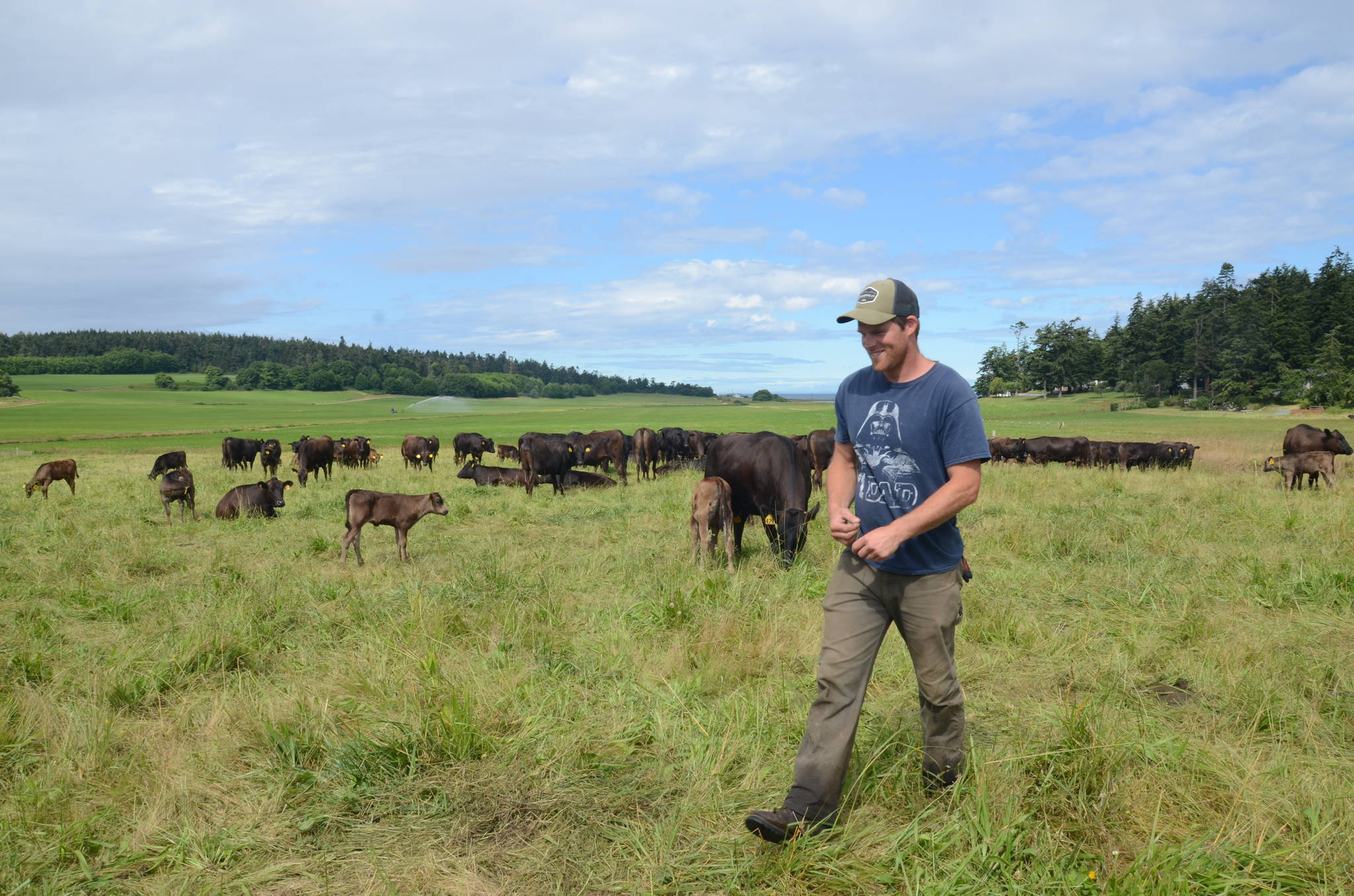Cory Fakkema gets up early most mornings to herd his 100 prized Wagyu (also known as Kobe) beef cattle from the pasture they had devoured the day before to the adjacent pasture with sweet, knee-high grass waving in the breeze. Then he hauls the egg-laying chickens in their mobile house to the first pasture to let the chickens eat and enjoy what the cattle left behind.
Fakkema practices a new kind of farming called regenerative agriculture on his family’s very old farm near Oak Harbor.
“We bring the animals to the food instead of bringing the food to the animals,” he explained.
Traditionally, farmers let their livestock graze continuously on an open pasture for several days.
The livestock eat everything they like — the “ice cream,” as Cory calls it — and leave behind the weeds and other unpalatable plants.
Over time, weeds take over the pasture and reduce the quality of the soil by extracting its nutrients. Hay and other feed must then be grown, harvested and given to the animals.
“We move the cows to a different pasture every day in which the grass has expressed its full growth and pushed out the weeds,” he said. The cows eat the tall grass and leave it behind as manure, which replenishes the soil and encourages water retention.
Enter the chickens whose scratching and pecking takes care of any insects and larvae attracted to cow manure, and help it quickly break down the soil. After the animals eat their fill, the pasture is given up to several months to regrow.
“It’s just happy, healthy animals moving around from pasture to pasture,” Cory said. “We don’t have to haul feed to the animals except in the coldest winter months. And we don’t have to pick up after them and slurry their waste, stink up the neighborhood and vaporize nitrogen into the air.”
He has a degree in environmental science from Western Washington University and applies that background to farming.
“Humans actually can increase the ecological diversity and abundance through well-managed interactions with nature,” he said. “Proper stewardship can improve health, quality and resilience just as much as poor management can deteriorate the land.”
Fakkema is the third generation to make a living on the family’s iconic farm that stretches out more than 300 acres from Swantown Road to West Beach Road. It’s called Beach View Farm; it has an uninterrupted sweeping vista of pasture and forest all the way to Swan Lake, the Strait of Juan de Fuca and beyond.
And, since 2016, its beauty has been conserved by a permanent easement, making it the largest single area of farmland area on Whidbey Island protected by the Whidbey Camano Land Trust.
It’s been a farm for at least 150 years and the Fakkemas have owned it for the past seven decades.
Through the years, it’s been a crop farm — potatoes, barley, oats, alfalfa, etc. Then it became a dairy farm under the management of Cory’s father Richard Fakkema and uncle Henry “Hap” Fakkema.
The dairy business ended in 2000, as it did for most dairy farms on Whidbey because of a sharp drop in milk prices and an increasing inability to compete with much larger dairy operations on the mainland.
For the next 15 years, the Fakkemas leased much of their land to others, who used it mostly to grow hay and other feed.
Enter Cory, now 32, with a brilliant idea. He was studying the work of Joel Salatin, an environmentalist and farmer in the Shenandoah Valley of Virginia, who developed the idea of regenerative agriculture and tied it to the local-grown food movement.
In his writing, Salatin talks about taking care of the land and treating the animals with respect.
“And in the process they have an enjoyable, healthy life and then we get to reap the rewards on our plates,” Cory added.
In 2015, he went to his dad and uncle to see if they were willing to try this idea at Beach View Farm. “Both gave me their blessing and I’ve been doing it ever since.”
It turned out to be an opportune moment. Growing older, Richard and Hap Fakkema began considering what to do with the farm they had inherited from their Dutch immigrant parents. Perhaps develop housing on part of it?
Maybe log some of the forest above the pastures? Instead, they decided to go with a Land Trust easement and keep the farm intact.
“To me, the easement was definitely a good thing, especially compared to the alternatives at the time, which would have been hundreds of houses, logging and maybe a horse arena,” Cory said.
“I get the chance to practice regenerative agriculture to improve the land. It went from potentially being destroyed to becoming an oasis next to the city of Oak Harbor.”
He said a public trail that the Land Trust will soon open through the Fakkema Farm easement from Swantown Road to Joseph Whidbey State Park will be a good thing.
“People will be able to walk through the pastures and see how well our animals are being raised and all we’re doing to restore and replenish the land.”
In addition to Wagyu beef and egg-laying chickens, Cory raises Katahdin sheep, a heritage breed known for “great lamb chops,” broiler chickens, some turkeys in time for Thanksgiving, and about 30 slower-growing heritage breed hogs “with great marbling and very tender meat.”
This year, he expects to butcher and sell 15 cattle, 10 lambs, a thousand chickens and a couple dozen pigs.
He also sells six to eight dozen eggs every day — by subscription only.
Most of his devoted customers live on Whidbey and demand for his products has steadily grown.
• Cory can be contacted via the farm’s website at www.beachviewfarm.com


